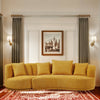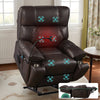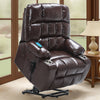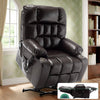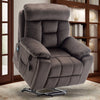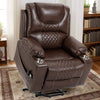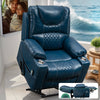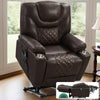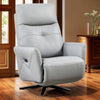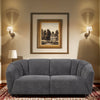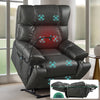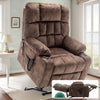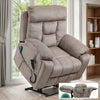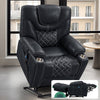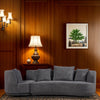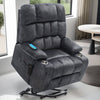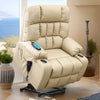The Rise of Recliner Chairs: A Historical Perspective
The Invention of the Recliner: Origins and Patents
The recliner chair has a rich history dating back to the late 19th century. It all began in 1850 when the French introduced a reclining camp bed for military use. However, the modern recliner as we know it today was invented by Edward Knabusch and Edwin Shoemaker in 1928. They founded the company La-Z-Boy, which became synonymous with recliners. Their first design was a wood-slat porch chair that reclined. Patents for various recliner mechanisms followed, including the famous La-Z-Boy mechanism patented in 1931.

The Comfort Revolution: Impact on Consumer Lifestyle
Recliners quickly became a symbol of relaxation and comfort in American homes. They revolutionized how people relaxed after a long day's work. The lay flat recliner chair, in particular, gained popularity for its ability to provide full-body support. This new furniture piece changed living room layouts and family dynamics. It became the coveted seat during movie nights and sports events. The recliner's impact on lifestyle was significant, promoting a culture of comfort and leisure in homes across the nation.
Technological Advancements in Recliner Design
Over the years, recliner technology has seen remarkable advancements. From manual mechanisms, we've moved to power recliners with electric motors. The introduction of massage features and heating elements enhanced the comfort factor. Memory foam and air cushions improved seat quality. Recent innovations include USB charging ports and cup holders. The lay flat recliner chair evolved to include zero-gravity positions for better circulation. These advancements have made recliners more versatile and appealing to a wider range of consumers.
Analyzing the Lay Flat Recliner Market in the United States
Demand and Popularity of Lay Flat Recliners
Lay flat recliners have seen a surge in demand in recent years. Their popularity stems from the ability to provide a fully horizontal position, ideal for napping or sleeping. The U.S. market has responded positively to this feature, especially among older consumers and those with back issues. The COVID-19 pandemic further boosted sales as people sought comfort at home. Market research shows that lay flat recliners now account for a significant portion of overall recliner sales in the country.

Key Players and Market Share Analysis
The lay flat recliner market in the U.S. is dominated by several key players. La-Z-Boy remains a market leader, leveraging its long history and brand recognition. Other major players include Ashley Furniture, Flexsteel, and Catnapper. These companies compete on factors like comfort, durability, and price. Newer entrants like Wayfair and Overstock have gained market share through online sales. The market is competitive, with companies constantly innovating to maintain their position.
Consumer Preferences Shaping the Recliner Industry
Consumer preferences have significantly influenced the evolution of lay flat recliners. Today's buyers prioritize:
- Comfort and support
- Durability and quality
- Style and aesthetics
- Additional features (e.g., USB ports, cup holders)
- Ease of use
The industry has responded by offering a wide range of options. From sleek, modern designs to traditional, overstuffed models, there's a lay flat recliner for every taste. Materials have also evolved, with leather and high-performance fabrics gaining popularity. The focus on customization has increased, allowing consumers to choose colors, fabrics, and features that suit their needs.
The Future of Recliners: Innovations and Potential Growth
The Emergence of Smart Recliners and IoT Integration
The future of recliners is becoming increasingly high-tech. Smart recliners are emerging, integrating Internet of Things (IoT) technology. These chairs can connect to smartphones and home automation systems. Features include:

- Voice-controlled adjustments
- Sleep tracking capabilities
- Personalized comfort settings
- Integration with smart home ecosystems
Some models even offer health monitoring features, such as heart rate and blood pressure tracking. As IoT technology advances, we can expect even more integration between recliners and other smart home devices.
Advancements in Recliner Mechanisms and Comfort Features
Recliner mechanisms continue to evolve, focusing on smoother operation and enhanced comfort. New developments include:
- Multi-motor systems for independent control of different chair sections
- Advanced zero-gravity positioning for improved circulation
- Pressure-relief systems that adjust to body weight and position
- Eco-friendly materials and sustainable manufacturing processes
- Improved lumbar support and adjustable headrests
These advancements aim to provide a more personalized and ergonomic seating experience. The focus is on creating recliners that not only offer comfort but also promote better health and posture.
Predicting Market Trends: What's Next for Recliner Chairs?
The recliner market is poised for continued growth and innovation. Several trends are likely to shape the industry:
- Increased focus on health and wellness features
- Growing demand for compact recliners in urban settings
- Rise of modular and customizable recliner designs
- Integration of virtual and augmented reality for shopping experiences
- Expansion of eco-friendly and sustainable recliner options
As technology advances, we may see recliners that adapt to users' moods or environmental conditions. The line between furniture and technology will continue to blur, creating exciting possibilities for the future of recliner chairs. The industry will likely focus on creating products that not only provide comfort but also contribute to overall well-being and lifestyle enhancement.







